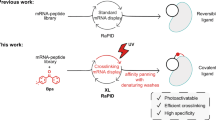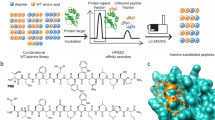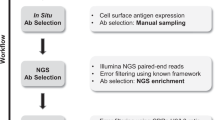Abstract
Aberrant changes in post-translational modifications (PTMs) such as phosphate groups underlie a majority of human diseases. However, detection and quantification of PTMs for diagnostic or biomarker applications often require PTM-specific monoclonal antibodies (mAbs), which are challenging to generate using traditional antibody-selection methods. Here we outline a general strategy for producing synthetic, PTM-specific mAbs by engineering a motif-specific 'hot spot' into an antibody scaffold. Inspired by a natural phosphate-binding motif, we designed and selected mAb scaffolds with hot spots specific for phosphoserine, phosphothreonine or phosphotyrosine. Crystal structures of the phospho-specific mAbs revealed two distinct modes of phosphoresidue recognition. Our data suggest that each hot spot functions independently of the surrounding scaffold, as phage display antibody libraries using these scaffolds yielded >50 phospho- and target-specific mAbs against 70% of target peptides. Our motif-specific scaffold strategy may provide a general solution for rapid, robust development of anti-PTM mAbs for signaling, diagnostic and therapeutic applications.
This is a preview of subscription content, access via your institution
Access options
Subscribe to this journal
Receive 12 print issues and online access
$209.00 per year
only $17.42 per issue
Buy this article
- Purchase on Springer Link
- Instant access to full article PDF
Prices may be subject to local taxes which are calculated during checkout




Similar content being viewed by others
References
Cohen, P. The regulation of protein function by multisite phosphorylation—a 25 year update. Trends Biochem. Sci. 25, 596–601 (2000).
Hanahan, D. & Weinberg, R.A. Hallmarks of cancer: the next generation. Cell 144, 646–674 (2011).
Blagoev, B., Ong, S.E., Kratchmarova, I. & Mann, M. Temporal analysis of phosphotyrosine-dependent signaling networks by quantitative proteomics. Nat. Biotechnol. 22, 1139–1145 (2004).
Zhou, H., Watts, J.D. & Aebersold, R. A systematic approach to the analysis of protein phosphorylation. Nat. Biotechnol. 19, 375–378 (2001).
Hornbeck, P.V., Chabra, I., Kornhauser, J.M., Skrzypek, E. & Zhang, B. PhosphoSite: A bioinformatics resource dedicated to physiological protein phosphorylation. Proteomics 4, 1551–1561 (2004).
Beausoleil, S.A. et al. Large-scale characterization of HeLa cell nuclear phosphoproteins. Proc. Natl. Acad. Sci. USA 101, 12130–12135 (2004).
Bendall, S.C. et al. Single-cell mass cytometry of differential immune and drug responses across a human hematopoietic continuum. Science 332, 687–696 (2011).
Sachs, K., Perez, O., Pe'er, D., Lauffenburger, D.A. & Nolan, G.P. Causal protein-signaling networks derived from multiparameter single-cell data. Science 308, 523–529 (2005).
Brumbaugh, K. et al. Overview of the generation, validation, and application of phosphosite-specific antibodies. Methods Mol. Biol. 717, 3–43 (2011).
Dopfer, E.P. et al. Analysis of novel phospho-ITAM specific antibodies in a S2 reconstitution system for TCR-CD3 signalling. Immunol. Lett. 130, 43–50 (2010).
DiGiovanna, M.P. & Stern, D.F. Activation state-specific monoclonal antibody detects tyrosine phosphorylated p185neu/erbB-2 in a subset of human breast tumors overexpressing this receptor. Cancer Res. 55, 1946–1955 (1995).
Nita-Lazar, A., Saito-Benz, H. & White, F.M. Quantitative phosphoproteomics by mass spectrometry: past, present, and future. Proteomics 8, 4433–4443 (2008).
Marks, J.D. et al. By-passing immunization. Human antibodies from V-gene libraries displayed on phage. J. Mol. Biol. 222, 581–597 (1991).
McCafferty, J., Griffiths, A.D., Winter, G. & Chiswell, D.J. Phage antibodies: filamentous phage displaying antibody variable domains. Nature 348, 552–554 (1990).
Kang, A.S., Barbas, C.F., Janda, K.D., Benkovic, S.J. & Lerner, R.A. Linkage of recognition and replication functions by assembling combinatorial antibody Fab libraries along phage surfaces. Proc. Natl. Acad. Sci. USA 88, 4363–4366 (1991).
Mersmann, M. et al. Towards proteome scale antibody selections using phage display. New Biotechnol. 27, 118–128 (2010).
Sidhu, S.S. et al. Phage-displayed antibody libraries of synthetic heavy chain complementarity determining regions. J. Mol. Biol. 338, 299–310 (2004).
Feldhaus, M.J. et al. Flow-cytometric isolation of human antibodies from a nonimmune Saccharomyces cerevisiae surface display library. Nat. Biotechnol. 21, 163–170 (2003).
Hanes, J., Schaffitzel, C., Knappik, A. & Pluckthun, A. Picomolar affinity antibodies from a fully synthetic naive library selected and evolved by ribosome display. Nat. Biotechnol. 18, 1287–1292 (2000).
Cobaugh, C.W., Almagro, J.C., Pogson, M., Iverson, B. & Georgiou, G. Synthetic antibody libraries focused towards peptide ligands. J. Mol. Biol. 378, 622–633 (2008).
Shih, H.H. et al. An ultra-specific avian antibody to phosphorylated tau protein reveals a unique mechanism for phosphoepitope recognition. J. Biol. Chem. 287, 44425–44434 (2012).
Vielemeyer, O. et al. Direct selection of monoclonal phosphospecific antibodies without prior phosphoamino acid mapping. J. Biol. Chem. 284, 20791–20795 (2009).
Kaneko, T. et al. Superbinder SH2 domains act as antagonists of cell signaling. Sci. Signal. 5, ra68 (2012).
Pershad, K., Wypisniak, K. & Kay, B.K. Directed evolution of the forkhead-associated domain to generate anti-phosphospecific reagents by phage display. J. Mol. Biol. 424, 88–103 (2012).
Malabarba, M.G. et al. A repertoire library that allows the selection of synthetic SH2s with altered binding specificities. Oncogene 20, 5186–5194 (2001).
Clackson, T. & Wells, J.A. A hot spot of binding energy in a hormone-receptor interface. Science 267, 383–386 (1995).
Bogan, A.A. & Thorn, K.S. Anatomy of hot spots in protein interfaces. J. Mol. Biol. 280, 1–9 (1998).
Watson, J.D. & Milner-White, E.J. A novel main-chain anion-binding site in proteins: the nest. A particular combination of phi,psi values in successive residues gives rise to anion-binding sites that occur commonly and are found often at functionally important regions. J. Mol. Biol. 315, 171–182 (2002).
Landry, R.C. et al. Antibody recognition of a conformational epitope in a peptide antigen: Fv-peptide complex of an antibody fragment specific for the mutant EGF receptor, EGFRvIII. J. Mol. Biol. 308, 883–893 (2001).
Hollingsworth, S.A. & Karplus, P.A. A fresh look at the Ramachandran plot and the occurrence of standard structures in proteins. Biomol Concepts 1, 271–283 (2010).
North, B., Lehmann, A. & Dunbrack, R.L. Jr. A new clustering of antibody CDR loop conformations. J. Mol. Biol. 406, 228–256 (2011).
Alving, C.R. Antibodies to liposomes, phospholipids and phosphate esters. Chem. Phys. Lipids 40, 303–314 (1986).
Levine, J.S., Branch, D.W. & Rauch, J. The antiphospholipid syndrome. N. Engl. J. Med. 346, 752–763 (2002).
Yaffe, M.B. & Smerdon, S.J. PhosphoSerine/threonine binding domains: you can't pSERious? Structure 9, R33–R38 (2001).
Kaneko, T., Joshi, R., Feller, S.M. & Li, S.S. Phosphotyrosine recognition domains: the typical, the atypical and the versatile. Cell Commun. Signal. 10, 32 (2012).
Seet, B.T., Dikic, I., Zhou, M.M. & Pawson, T. Reading protein modifications with interaction domains. Nat. Rev. Mol. Cell Biol. 7, 473–483 (2006).
Kunkel, T.A. Rapid and efficient site-specific mutagenesis without phenotypic selection. Proc. Natl. Acad. Sci. USA 82, 488–492 (1985).
Bostrom, J. et al. Variants of the antibody herceptin that interact with HER2 and VEGF at the antigen binding site. Science 323, 1610–1614 (2009).
Rondot, S., Koch, J., Breitling, F. & Dubel, S. A helper phage to improve single-chain antibody presentation in phage display. Nat. Biotechnol. 19, 75–78 (2001).
Thomsen, N.D., Koerber, J.T. & Wells, J.A. Structural snapshots reveal distinct mechanisms of procaspase-3 and -7 activation. Proc. Natl. Acad. Sci. USA 110, 8477–8482 (2013).
Luft, J.R. & DeTitta, G.T. A method to produce microseed stock for use in the crystallization of biological macromolecules. Acta Crystallogr. D Biol. Crystallogr. 55, 988–993 (1999).
Holton, J. & Alber, T. Automated protein crystal structure determination using ELVES. Proc. Natl. Acad. Sci. USA 101, 1537–1542 (2004).
Otwinowski, Z. & Minor, W. Processing of X-ray diffraction data collected in oscillation mode. Methods Enzymol. 276, 307–326 (1997).
Adams, P.D. et al. PHENIX: a comprehensive Python-based system for macromolecular structure solution. Acta Crystallogr. D Biol. Crystallogr. 66, 213–221 (2010).
Kaufmann, B. et al. Neutralization of West Nile virus by cross-linking of its surface proteins with Fab fragments of the human monoclonal antibody CR4354. Proc. Natl. Acad. Sci. USA 107, 18950–18955 (2010).
Emsley, P. & Cowtan, K. Coot: model-building tools for molecular graphics. Acta Crystallogr. D Biol. Crystallogr. 60, 2126–2132 (2004).
Chen, V.B. et al. MolProbity: all-atom structure validation for macromolecular crystallography. Acta Crystallogr. D Biol. Crystallogr. 66, 12–21 (2010).
Baker, N.A., Sept, D., Joseph, S., Holst, M.J. & McCammon, J.A. Electrostatics of nanosystems: application to microtubules and the ribosome. Proc. Natl. Acad. Sci. USA 98, 10037–10041 (2001).
Winn, M.D. et al. Overview of the CCP4 suite and current developments. Acta Crystallogr. D Biol. Crystallogr. 67, 235–242 (2011).
Acknowledgements
We thank members of the Wells laboratory for helpful discussions regarding this manuscript and S. Pfaff for assistance with Biacore experiments. We thank C. Waddling at the UCSF X-ray facility for assistance with generating protein crystals and J. Holton, G. Meigs and J. Tanamachi at the Advanced Light Source beam line 8.3.1 at the Lawrence Berkeley National Laboratory for help with collection of diffraction data. We thank the Court laboratory at the National Institutes of Health for generously providing the recombineering vectors. J.T.K. is a Fellow of the Life Sciences Research Foundation and N.D.T. is the Suzanne and Bob Wright Fellow of the Damon Runyon Cancer Research Foundation. This work was supported by grants from the US National Institutes of Heath (R01 CA154802 to J.A.W. and GM54616 to W.F.D.). J.T.K., J.A.W. and W.F.D. have filed a provisional patent on the technology described in this manuscript.
Author information
Authors and Affiliations
Contributions
J.T.K. designed and executed experiments; N.D.T. assisted with crystallography experiments; B.T.H. and W.F.D. assisted with modeling experiments; J.A.W. designed and supervised experiments. J.T.K. and J.A.W. wrote the manuscript with input from all co-authors.
Corresponding author
Ethics declarations
Competing interests
J.T.K., W.F.D. and J.A.W. have filed a provisional patent regarding the technology described in this manuscript.
Supplementary information
Supplementary Text and Figures
Supplementary Figures 1–7 and Supplementary Tables 1–7 (PDF 5190 kb)
Rights and permissions
About this article
Cite this article
Koerber, J., Thomsen, N., Hannigan, B. et al. Nature-inspired design of motif-specific antibody scaffolds. Nat Biotechnol 31, 916–921 (2013). https://doi.org/10.1038/nbt.2672
Received:
Accepted:
Published:
Issue Date:
DOI: https://doi.org/10.1038/nbt.2672
This article is cited by
-
Stereochemical engineering yields a multifunctional peptide macrocycle inhibitor of Akt2 by fine-tuning macrocycle-cell membrane interactions
Communications Chemistry (2023)
-
Site-Specific Labeling of F-18 Proteins Using a Supplemented Cell-Free Protein Synthesis System and O-2-[18F]Fluoroethyl-L-Tyrosine: [18F]FET-HER2 Affibody Molecule
Molecular Imaging and Biology (2019)
-
Tau Antibody Structure Reveals a Molecular Switch Defining a Pathological Conformation of the Tau Protein
Scientific Reports (2018)
-
Novel method for the high-throughput production of phosphorylation site-specific monoclonal antibodies
Scientific Reports (2016)
-
A phosphorylation pattern-recognizing antibody specifically reacts to RNA polymerase II bound to exons
Experimental & Molecular Medicine (2016)



